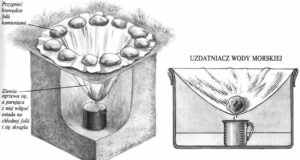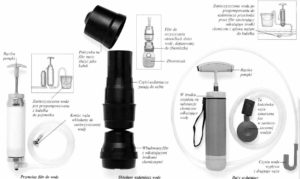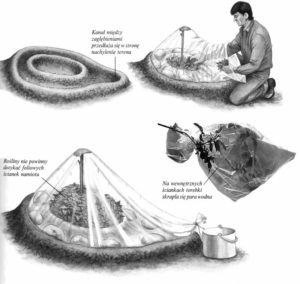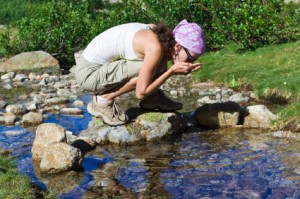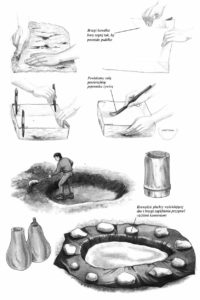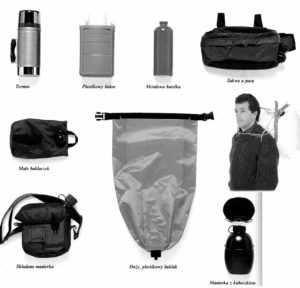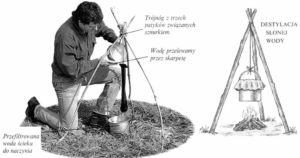 Filtr na trójnogu
Filtr na trójnogu
Jeśli nie masz uzdatniacza, możesz przed przegotowaniem przefiltrować wodę przez skarpetę. Włóż w środek grubo dzianej skarpety cienką skarpetkę lub chustkę i nasyp piasku. Po przelaniu wody przez taki filtr należy wywinąć skarpetkę, wysypać jej zawartość i wypłukać. Można też dla ułatwienia postawić trójnóg z patyków i na nim zawiesić skarpetę.
DESTYLACJA SŁONEJ WODY
W sytuacjach krytycznych można pozyskać czystą słodką wodą przez destylację słonej wody morskiej (tak samo można pozyskać wodę z moczu). Słoną wodę należy gotować pod przykryciem w kociołku.
Gdy materiał nasiąknie parą wodną, zdjąć go i przykryć kociołek następnym. Nasiąknięty parą wodną materiał należy zdejmować patyczkiem.
Na skutek ochładzania się materiału para wodna skropli się, wówczas należy wyżąć materiał – uzyskuje się czystą, słodką wodę.
Zagrożenia
Zwierzęta pijąc u wodopoju zakażają wodę różnymi mikroorganizmami i pasożytami przewodu pokarmowego, które mogą powodować groźne choroby u ludzi. Niektóre z tych chorób są bardzo przewlekłe i niebezpieczne, inne mają przebieg gwałtowny. Człowiek w mieście stale pije oczyszczoną wodę, nie jest więc uodporniony na tego typu zarazki i dlatego grożą mu choroby spowodowane piciem zakażonej wody. Na przykład górskie s:rumienie wydają się być idealnie czyste, ale najbezpieczniej jest wodę czerpaną z naturalnych źródeł zawsze odkazić przed wypiciem. Do ziemi trafia obecnie mnóstwo środków chemicznych, w wielu osiedlach ścieki odprowadza się wprost do strumienia albo jeziora, nigdy więc nie możemy być pewni, czy czerpana przez nas woda jest zdatna do picia.
OZNAKI ZANIECZYSZCZENIA
O tym, że woda z jakiegoś źródła jest niezdatna do picia, świadczą nie tylko kości i czaszki padłych zwierząt. Jeśli podejrzewasz, że woda jest skażona chemikaliami, obejrzyj brzegi, sprawdź, czy nie ma osadu z dziwnie wyglądających substancji. Można też zagotować małą ilość wody z takiego zbiornika, a potem obejrzeć osad w naczyniu. Brak roślinności lub obfitość zielonych glonów na powierzchni również wskazuje, że woda nie nadaje się do picia.
Zarastająca sadzawka
Las trzcin świadczy o stojącej wodzie, której należy się wystrzegać.
Choroby przenoszone w wodzie
Leptospirozy (krętkowice) – Choroby zakaźne odzwierzęce wywoływane przez krętki z rodzaju Leptospira. Zakażenie następuje przez zetknięcie z kałem zwierząt nosicieli. Zarazki dostają się do organizmu najczęściej przez uszkodzoną skórę. Podobne do grypy (gorączka, dreszcze, bóle głowy i mięśni). Cięższe postacie choroby mogą prowadzić do zapalenia opon mózgowych, żółtaczki, niewydolności nerek i chorób serca.
Schistosomatoza (bilharcjoza) – Choroba wywoływana przez przywry z rodzaju Schistosoma żyjące w wolno płynących, słodkowodnych rzekach i strumieniach. Pasożyt ten umiejscawia się w jelitach lub pęcherzu moczowym. Świerzbienie, pokrzywka, ataki kaszlu, zapalenie i owrzodzenie pęcherza moczowego oraz innych odcinków dróg moczowych, a także powiększenie wątroby.
Ameboza (czerwonka pełzakowa) – Choroba wywoływana przez pełzaka (amebę) Erttamoeba histolytica. Zakazić się można pijąc wodę zanieczyszczoną fekaliami. Krwawa biegunka, bóle w jamie brzusznej, wzdęcia, gorączka. W postaci przewlekłej obserwuje się powiększenie wątroby oraz zapalenie jelita grubego.
Ancylostomatoza (nekatorioza) – Choroba inwazyjna wywoływana przez nicienie z rodzaju Ancylastoma. Pasożyt dostaje się do organizmu wraz z wypitą zakażoną wodą. Anemia, ospałość, a także świąd i zapalenie skóry. Mogą dołączyć się do tego objawy ze strony układu pokarmowego oraz nerwowego.
Lamblioza – Choroba pasożytnicza wywoływana przez wiciowca – lamblię jelitową (Lamblia intestinalis). Zakażenie następuje przez wypicie wody zanieczyszczonej moczem lub fekaliami. Biegunka i zapalenie dróg żółciowych. Choroba notowana najczęściej w Ameryce Północnej, Afryce i Azji.
Zapobieganie chorobom
Jedynym pewnym sposobem uniknięcia zarażenia jest odkażanie za każdym razem wody przeznaczonej do picia lub gotowania. Jeśli ktoś z członków wyprawy zachoruje po wypiciu wody, należy odizolować go wraz z opiekunem od grupy. Muszą mieć oni osobne naczynia, garnki, sztućce. Szczególną uwagę należy zwrócić na to, aby zaraza nie rozniosła się przez odchody chorego. Zawierają one bowiem sporo drobnoustrojów, które wywołały dolegliwość.
W obozowisku, w którym pojawiły się przypadki zatrucia wodą, powinno się zaostrzyć zasady przestrzegania higieny, aby zapobiec dalszemu rozszerzaniu się choroby.
